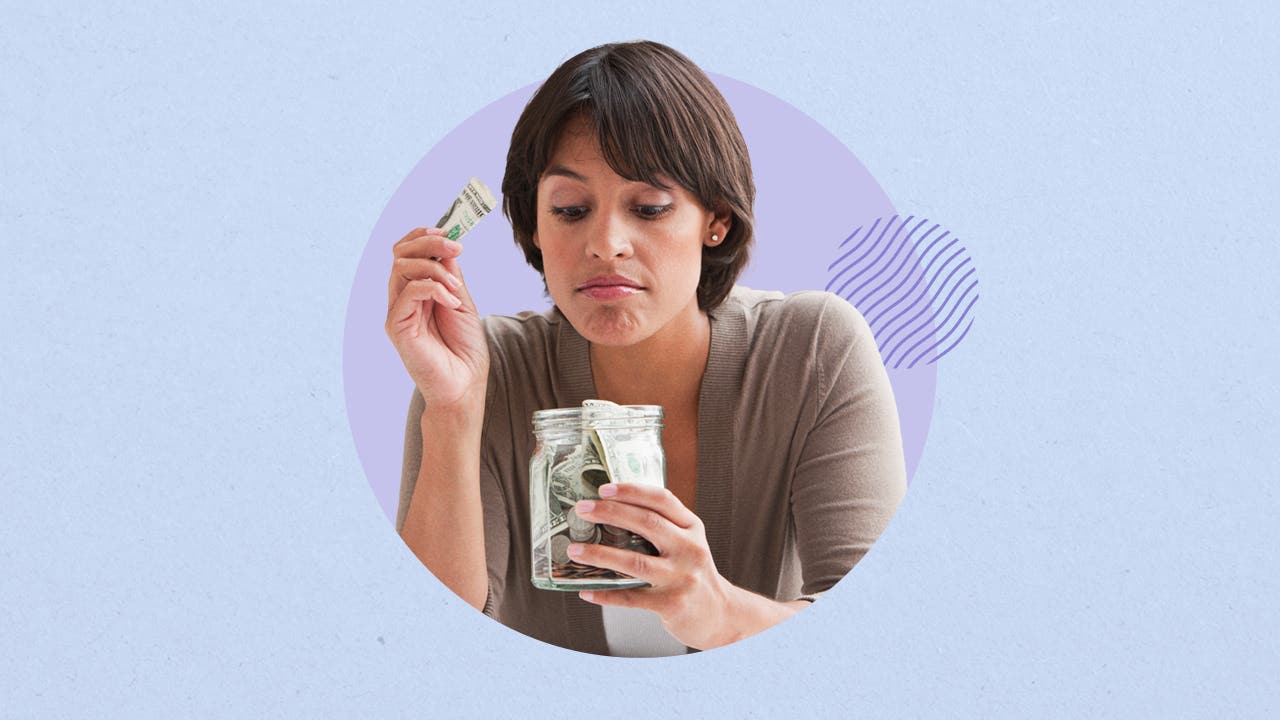Singles are fronting the bill alone in a pricey America — and it’s costing them their savings

The Bankrate promise
At Bankrate we strive to help you make smarter financial decisions. While we adhere to strict , this post may contain references to products from our partners. Here's an explanation for .
It’s the little things that add up when you live alone. Bags of lettuce are far too large to eat before they spoil. Hotel rooms have to be paid in full. Leaving the house to see another person often means pricey dinners and drinks out.
Eve Tilley-Coulson, a 35-year-old in Los Angeles, knows how tricky budgeting can be as a single woman. Not only do large amounts of groceries go to waste, but she’s a busy attorney, and without someone to help, she often pays for pricey routine services like house cleaning or dog boarding.
“As an attorney, everything is billed in 6-minute increments,” Tilley-Coulson says. “I’m very conscious of time and time is money. If it’s going to take me 45 minutes to cook this meal and then I’m just going to eat it by myself, and then it’s going to take me 30 minutes to clean it up — that’s effectively money.”
The struggle of shouldering bills alone doesn’t only affect day-to-day spending; it affects singles’ abilities to save for the future. Only 29 percent of people who are not married or don’t live with a partner would pay a $1,000 emergency expense from their savings — indicating that they may simply not have enough money saved. Nearly twice as many people (55 percent) who are married or live with a partner would pay from their savings.
It can seem difficult to both pay the bills yourself and build your savings as a single person. But it’s still possible to enjoy your life while saving. Here’s how.
With only one income and no one to split expenses with, inflation and rising interest rates are likely weighing more on single Americans’ budgets and ability to save.— Alex Gailey | Bankrate Senior Data Reporter
Bankrate’s insights on singles and emergency savings
- Many singles are worried about their future in an emergency. If they lost a primary source of household income tomorrow, 51% of U.S. adults who are not married or living with a partner would be worried they wouldn’t have enough emergency expenses to cover their immediate living expenses for the next month, according to Bankrate’s emergency savings survey. That’s compared to 35% of people who are married or live with a partner and feel the same way.
- If needed, they’ll more often turn to friends or family. 16% of people who are not married or living with a partner would borrow from family or friends to pay an emergency $1,000 expense, compared to 6% of people who are married or living with a partner, according to the same survey.
- Financial security is harder for people paying the bills alone. Only 23% of U.S. adults who are single feel completely financially secure, compared to 32% of people in a relationship, as of June 2023. On the flip side, 52% of singles say they are not completely financially secure but will be someday, compared to 45% of people in a relationship.
Singles spend more than $4,000 more per year on housing than those living with their partners
You’ll buy groceries for two when living with a partner, but couples still save thousands of dollars a year in total spending compared to those living alone.
Americans in a single-consumer, single-earner household spent an average total of $50,858 in 2022, according to consumer spending data from the U.S. Bureau of Labor Statistics (BLS). In comparison, a person in a two-consumer (or more), two-earner household spent $47,390 on average, assuming both earners split expenses equally.
The biggest spending difference between single-earner and two-earner households was shelter, which could mean rent or a mortgage payment. Someone in a single-earner, single-consumer household spent $13,095 on average on shelter in 2022, while someone in a two-earner household spent $8,808 on average — a 49 percent difference.
A single-earner household also spent more, on average, on home-related expenses and utilities:
Source: BLS
Note: Data has not been released yet for 2023.
Note: A single consumer unit with one earner is likely a worker living by themselves. Someone in a consumer unit of two or more people with two earners could be part of a working married couple with young children, or two roommates who both work.
Bankrate Senior Reporter Alex Gailey says the past two years of rising inflation has created added pressure for single people to reduce their expenses, or even look for additional income, if they ever hope to build emergency savings.
“In the most recent inflation report, housing costs accounted for more than half the increase in prices,” Gailey says. “Many singles are having to get creative by living with multiple roommates or moving further out of cities. Some are even moving back home to help take some pressure off their budgets.”
Bankrate’s take: In 2022, singles spent $4,693 more on average on shelter, home-related maintenance and utilities than people living with a partner, according to U.S. BLS data analyzed by Bankrate.
The cost of shelter likely makes up the largest percentage of a single person’s budget, so rising prices can make housing a serious financial burden. U.S. home prices rose 3.7 percent between December 2022 and December 2023, according to Redfin.
Meanwhile, the cost of renting improved year over year, but only slightly. U.S. rent prices fell by 0.78 percent between December 2022 and December 2023, according to Rent.com. But the U.S. median asking rent still rose from $1,637 in February 2019 to $1,964 in December 2023.
How paying more for housing affects singles’ savings
Singles spending more on their housing costs than people living with a partner may have a harder time diversifying how they save, or even saving at all. Without a second source of income at home and without significant emergency savings, around 1 in 2 singles are worried about a financial emergency.
If they were to lose their primary source of household income tomorrow (such as a job loss), 51 percent of people not married or living with a partner say they would be very worried about not having enough emergency savings to cover their immediate living expenses over the next month, according to Bankrate’s survey on emergency savings. Only 35 percent of people married or living with a partner say the same.
If housing is more than 30 percent of your budget, Gailey recommends considering moving to a more affordable area, or living with roommates or family, even if it’s just for a little while.
“Lowering your housing costs will free up your budget to save more, pay down debt and spend more on the things you enjoy,” Gailey says.
Singles can add money to their emergency fund without sacrificing their social life
Cutting down on discretionary spending to save money isn’t always easy. But it’s especially hard when going out is a key way to socialize as a single person.
Like many people who live alone and work from home, Tilley-Coulson tends to spend more money on dates, nights out and vacations. She wishes she wasn’t spending more, but she feels the expense is necessary.
“You’re incentivized to get that interaction that you’re not naturally getting on a daily basis, especially working from home,” Tilley-Coulson says. “I could theoretically wake up and work from 8 a.m. to 6 p.m. at my computer, not see a single person, walk my dog, come home, eat dinner by myself and repeat. The mental toll is not ideal.”

However, it is possible to both socialize and save, and turning to your friends, family and community can be a key way for singles to feel empowered to save. Julia Lilly, a Houston-based certified financial planner, advises being open with loved ones that you’re on a budget.
By being more thoughtful with gatherings, such as holding potlucks, Lilly finds her clients can reach a healthy middle ground. She recommends people have tough conversations on what budget they have to go out.
“Have a little more fun with that process, versus more of that shame cycle of ‘Oh, I can’t go because it’s too expensive,’” she says. “(Try) to be more transparent, because I think most people would be surprised that others are in a similar boat, but don’t talk about it.”
3 tips to make an attainable savings goal
No matter who’s in your household, it’s often difficult to make room in your budget for savings. However, setting at least one specific goal can help. If you struggle with trying to save more, consider these tips to help crush your savings goals in 2024.
1. Set specific savings goals
Making specific savings goals, instead of a vague goal like “save more,” can motivate you, according to Lilly. If you struggle to keep your priorities in check between discretionary spending and savings, it can help to think about how much you’d rather spend money on your vacation in the future, rather than an impulsive purchase now.
Money tip: Break your goals out into short-, medium- and long-term plans, and be specific about the amount of money you want to save and what you want to save it for. For example, instead of keeping a general vacation fund, turn that into a goal of 'save $100 to see your favorite band play in June.' The specific place, time frame and amount will keep your goal focused and realistic.
2. Align your budget to your goals
Consider re-examining your budget to make sure it’s aligned with your savings goals and priorities. If you haven’t looked at your budget in a while, take it out and examine your spending from the past month. What are you spending too much on that you would rather allocate to savings? Could you hold off on some purchases until your savings goal is met? Think about your financial priorities and make sure your money’s going where you want it to go.
“If you want to save money in this economy, you have to focus on the things you can control,” Gailey says. “Building savings starts with a budget. In order to know if you’re spending more than you’re earning, you have to keep track of how much is coming in and how much is going out — and know exactly where that money is going.”
3. Celebrate wins
Meeting a savings goal isn’t as flashy as buying something new for yourself, but it’s worth bragging about, too. Lilly advises that her clients be open about their financial wins with the people around them so they can feel proud of their accomplishments. Don’t forget, building savings is a huge achievement. Treat it like one just like you’d treat any other big purchase in your life.
“I don’t think we encourage that behavior of, ‘Hey that’s awesome that you saved for the travel … or you saved for that car,’” Lilly says, “Versus saddling yourself with debt that you’re going to be looking at for a lot longer.”
FAQs
-
The cost of renting an apartment or house varies widely in the U.S., but it’s wise to avoid spending more than 30 percent of your pretax salary on rent.
-
It’s common to keep three to six months of expenses saved in case of emergencies.
-
Be clear about your financial philosophy early on in dating. Discuss how you spend money, whether you want to split bills in the future and your goals for the future. Open and honest communication is key.
Methodology
The study on emergency savings was conducted by SSRS on its Opinion Panel Omnibus platform. The SSRS Opinion Panel Omnibus is a national, twice-per-month, probability-based survey. Data collection was conducted from December 15 – December 17, 2023, among a sample of 1036 respondents. The survey was conducted via web (n=1006) and telephone (n=30) and administered in English (n=1010) and Spanish (n=26). The margin of error for total respondents is +/-3.6 percentage points at the 95% confidence level. All SSRS Opinion Panel Omnibus data are weighted to represent the target population of U.S. adults ages 18 or older.
Bankrate commissioned YouGov Plc to conduct the survey on financial freedom. All figures, unless otherwise stated, are from YouGov Plc. Total sample size was 2,521 U.S. adults. Fieldwork was undertaken June 5-7, 2023. The survey was carried out online and meets rigorous quality standards. It employed a non-probability-based sample using both quotas upfront during collection and then a weighting scheme on the back end designed and proven to provide nationally representative results.
Related Articles

Top high-yield savings accounts are now beating inflation. Here’s why that’s important

Should you open a health savings account? Here are the pros and cons

